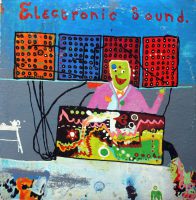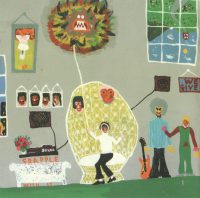Cover artwork
George Harrison created the painting on the front and back cover of Electronic Sound. The two images were originally part of a single larger picture.The front cover depicts Bernie Krause, wearing a bow tie and controlling the Moog synth. Harrison’s smiling blue face is at the bottom of the image. The green figure represents Jostick, one of Harrison’s cats.
The back cover showed Derek Taylor seated in Apple’s press office, overlooked by Neil Aspinall and Mal Evans. The figure in blue on the right is Eric Clapton.
The album carried the liner note: “There are a lot of people around, making a lot of noise; here’s some more.”
Harrison gave the Electronic Sound painting to his son Dhani, who hanged it in his bedroom. Dhani Harrison wrote his recollections of discussing the image in the liner notes for the 2014 reissue of the album.
I remember one day as a teenager sitting with my dad as we went through a bunch of old framed art that sat in a corridor of the part of the house that I had moved back into having returned from my first year at university.There, leaning against a wall, looking rather neglected, sat a wonderful psychedelic painting on acetate. I immediately said, ‘Ooh. Can I have this?’
To which he responded, ‘Err. Yeah. Sure…’ hesitantly. ‘That’s my painting that I did for the cover of Electronic Sound.’
‘Cool,’ I said, nodding as if to imply I knew even vaguely what he was talking about.
He then nodded back at me, knowing full well I had no clue but would probably work it out eventually due to my own sense of curiosity, as it was one of his stranger drawings I’ve seen to date.
The older I got the more I came to realise the value, nay, priceless nature of some of the random objects that sat, forlorn, in the rooms near the studio and the corridor that led from there to my bedroom. Things I passed every day going to and from school to my room that I never gave any thought to but were, in fact, great clues to entire aspects of my future life that I was yet to know. Right there, staring me in the face. Everyday. This drawing was one such item.
One day I asked him, ‘So remember that funny drawing that you gave me?’
He said, ‘Which one?’
To which I laughed and replied, ‘The one with the loony standing over a trippy meat grinder, and a guy flying an angry kite indoors. What was that all about?’
‘Ah! Good!’ he remarked. ‘Where is that? You have it?’
So we climbed the stairs to my room and stood staring at the thing itself, hanging in all its wonderful, childish glory, and this is what he said.
‘That’s Derek (Taylor) holding on to all of Apple’s aggravation and problems that are looming over everyone (Angry Kite). We have to grapple with it, y’know? That’s Neil (Aspinall, frowning) and Mal (Evans, smiling) with him in the chair. That’s Eric (Clapton) on the right there and the green guy on the front is Bernie (Krause), with his bowtie and pocket square, patching everything through the board and out comes the sound (Trippy Meat Grinder).
That’s me making the tea (Small Blue Face Smiling) and that’s the cat, Jostick’ he said pointing to the small green demon like figure on the front cover.
‘Wow,’ I replied, and so began my journey into the world of Electronic Sound.
The release
Electronic Sound was released in the United Kingdom on 9 May 1969, and in the USA on 26 May.
In the US and Canada, the album was pressed with the two tracks swapped around, which for several years led to confusion as to which was which. The order was finally corrected worldwide for the compact disc reissue in 1996.
Electronic Sound was one of two launch records for Zapple Records, The Beatles’ short-lived experimental label. The other, released at the same time, was John Lennon and Yoko Ono’s Unfinished Music No 2: Life With The Lions.
Zapple was created to release experimental solo albums by The Beatles, along with spoken word and avant-garde recordings from other artists. It was run by Barry Miles, a friend of Paul McCartney; Miles later wrote McCartney’s authorised biography, Many Years From Now.
See, we conceived of an offshoot of Apple Records that would be arty music that wouldn’t normally gain an outlet, a series where people could talk or read their work, as with the Brautigan thing. The intention was to get Lenny Bruce and all these kinds of people. But as with so many other things at Apple, it seized up before it really got going. Both of the albums that did come out are a load of rubbish, yet they’re interesting from a collector’s point of view. The theory was, we wanted to let serendipity take hold.
George Harrison: Reconsidered, Timothy White
Electronic Sound was issued as Zapple 02. It was Harrison’s second solo release, following November 1968’s Wonderwall Music.
Acetate copies of a third Zapple album – a spoken word release by the writer Richard Brautigan which was to have been Zapple 3 – were pressed. There were also plans to release spoken word albums by Lawrence Ferlinghetti and Michael McClure, as well as a recording of a UK appearance by comedian Lenny Bruce, but these never came to fruition.
The Zapple label was folded by Klein before the record could be released. The first two Zapple records did come out. We just didn’t have [Brautigan’s record] ready in time before Klein closed it down. None of the Beatles ever heard it.
Zapple lasted until June 1969, when the label was closed by Allen Klein.
Electronic Sound was not well received by critics. Ed Ward of Rolling Stone was one of the more forgiving, writing that Harrison had “done quite well learning his way around his new Moog Synthesizer in such a short time, but he’s still got a way to go”. He added: “The textures presented are rather mundane, there is no use of dynamics for effect, and the works don’t show any cohesiveness to speak of. However, if he’s this good now, with diligent experimentation he ought to be up there with the best in short order.”
The album was remastered for Harrison’s 2014 box set The Apple Years 1968–75.
In the United States and Canada, the LP was pressed with the two tracks swapped around, leading to confusion regarding the identity of the pieces. The order was corrected for the album’s CD release in 1996. The 2014 reissue includes essays by Kevin Howlett and electronica musician Tom Rowlands, along with Dhani Harrison’s explanation of his father’s artwork.




Bernie Krause sure sounds bitter and angry, which, to me, adversely affects his credibility and the tone of his recollection. If he really felt that it was his work and George Harrison was putting it out as his, why didn’t he sue to get the rights to the songs, the album, etc. It would have been a great financial windfall for him. I just find his story incredible as in not credible.
Absolute garbage. Playing off the Beatles name. just like Lennon with the nonsense he puts out with Ono.